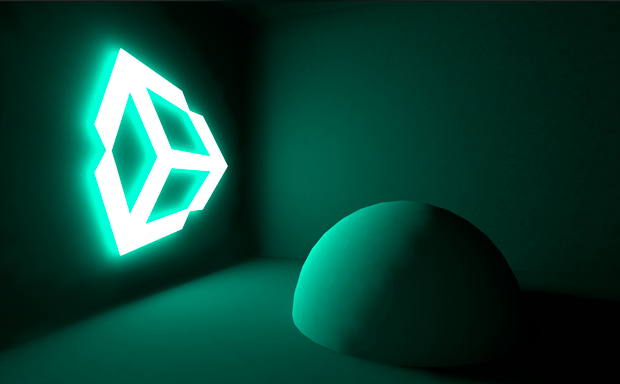Emissive Materials 自发光材质
Whilst Area Lights are not supported by Precomputed Realtime GI, similar soft lighting effects are still possible using ‘Emissive Materials.’ Like Area Lights, emissive materials emit light across their surface area. They contribute to bounced light in your scene and associated properties such as color and intensity can be changed during gameplay.
尽管预计算实时GI不支持区域灯光,但使用“发光材料”仍可实现类似的柔和灯光效果。与区域灯光一样,发光材料在其表面区域发光。它们有助于场景中的反射光线,并可在游戏过程中更改颜色和强度等相关属性。
‘Emission’ is a property of the Standard Shader which allows static objects in our scene to emit light. By default the value of ‘Emission’ is set to zero. This means no light will be emitted by objects assigned materials using the Standard Shader. The HDR color picker can be used to select colors with intensities beyond the 0-1 range in order to create bright light effects similar to those of Area Lights.
'发射'是标准着色器的一个属性,它允许我们场景中的静态物体发光。默认情况下'发射'的值被设置为零。这意味着使用标准着色器的物体指定材料不会发射光。 HDR颜色选择器可用于选择强度超过0-1范围的颜色,以创建类似于区域灯光的明亮灯光效果。
There is no range value for emissive materials but light emitted will again falloff at a quadratic rate. Emission will only be received by objects marked as ‘Static’ or “Lightmap Static’ from the Inspector. Similarly, emissive materials applied to non-static, or dynamic geometry such as characters will not contribute to scene lighting.
自发光材质没有范围值,但发射的光线会以二次方速率再次下降。自发光只能由inspector面包标记为“静态”或“光照贴图静态”的对象接收。同样,应用于非静态或动态几何体(如角色)的自发光材质也不会影响场景照明。
However, materials with an emission above zero will still appear to glow brightly on-screen even if they are not contributing to scene lighting. This effect can also be produced by selecting ‘None’ from the Standard Shader’s ‘Global Illumination’ Inspector property. Self-illuminating materials like these are a useful way to create effects such as neons or other visible light sources.
然而,即使没有对现场照明作出贡献,零辐照度以上的材质仍然会在屏幕上亮起。这种效果也可以通过从标准着色器的“‘Global Illumination(全局照明)”Inspector面板属性中选择“None无”来产生。像这些自发光材质是制作诸如霓虹灯或其他可见光源的效果的有用方式。
 Simple neon sign created using the ‘Emission’ property of Unity’s Standard Shader. Notice how the emission from the sign is still shadowed by static geometry - in this case, the sphere.
Simple neon sign created using the ‘Emission’ property of Unity’s Standard Shader. Notice how the emission from the sign is still shadowed by static geometry - in this case, the sphere.
使用Unity标准着色器的“_Emission(_辐射_)_”属性创建简单的霓虹灯。 请注意,_在这种情况下_标志的自发光仍然使静态几何体的球体产生阴影。
Emissive materials only directly affect static geometry in your scene. If you need dynamic, or non-static geometry - such as characters, to pick up light from emissive materials, Light Probes must be used. Changing emission values at gameplay will update Light Probes interactively and the results will be visible on any objects presently receiving light from those probes.
自发光材质仅直接影响场景中的静态几何体。 如果您需要动态或非静态几何体(如字符)来接受自发光材质的光,则必须使用Light Probes(光照探针)。 在游戏中更改辐照值将交互式更新光照探针,结果将作用于受到这些探针作用的任何对象上。
来源: https://unity3d.com/cn/learn/tutorials/topics/graphics/emissive-materials?playlist=17102














